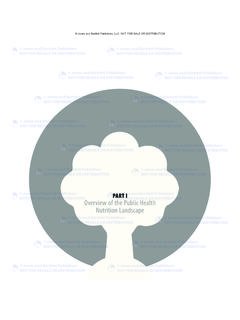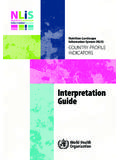Transcription of A Review of Nutrition Policies - WHO
1 Draft Global Nutrition Policy Review : 20 December 2010 1 A Review of Nutrition Policies Draft report 20 December 2010 The Review is based on a comprehensive survey questionnaire sent to WHO Member States in July 2009 and the responses received up to November 2010 were included in the analysis. The responses were provided by the total of 119 countries and four territories, covering 81% of the world population. Peer- Review was undertaken during October - November 2010 by external experts as well as by the representatives of concerned WHO Departments and Regional Offices. Thirteen detailed peer- Review comments were received. When preparing this revised draft, some of these peer- Review comments were taken into consideration. It should be noted, however, that many of the comments have not yet been addressed in this draft and these are currently being undertaken with a view to prepare a final draft after the open call for comments for the preparation of the 128th Session of the Executive Board in January 2011.
2 Draft Global Nutrition Policy Review : 20 December 2010 2 Table of contents Acronyms .. 7 Glossary .. 9 1. Introduction .. 12 2. Current health and Nutrition 14 Malnutrition in all its forms .. 16 Stunting, underweight, overweight and acute malnutrition in 16 Overweight in 23 Vitamin and mineral 24 Infant and young child 31 Dietary energy 35 3. The evolving nature of Nutrition challenges ..37 What are the key challenges and how to conceptualise them? .. 37 Immediate, underlying and basic (upstream) 37 Social determinants of 38 40 Factors affecting food and Nutrition insecurity: climate change and the food price crisis42 4. Evolving global and regional macropolicy context on 44 Complexity of Global Food and Nutrition 44 Changing global Nutrition policy and strategy 47 Regional plans of action .. 54 Draft Nutrition strategy and plan of action for countries of the Eastern Mediterranean region.
3 2010 54 WHO European action plan for food and Nutrition policy 55 African Regional Nutritional Strategy: 56 Case Study We are what we eat: communicating for political consensus and improved food security in the Pacific ..59 Case study Pan American Alliance for Nutrition and Development ..61 5. Policy analysis .. 62 Methodology of the 62 National policy and institutional 65 Draft Global Nutrition Policy Review : 20 December 2010 3 Review of Policies in topic areas .. 74 Maternal, Infant and Young Child 74 Case Study Promotion of Breastfeeding and BFHI in Case study Baby-friendly in New Zealand ..82 Case study The Philippines IYCF National Programme ..82 Case Study Breastfeeding in a Globalized World: A Public Health Success Case study Reductions in Stunting and Inequalities in Stunting in Case study Kuwait Nutrition Surveillance System [KNSS].
4 86 International Code of Marketing of Breast-milk 88 School-based 95 Vitamins and 97 Vitamins and 97 Case study Combating iodine deficiency disorders- The success story from 102 Case study Wheat Flour Fortification in 104 Case study The Yen Bai story: a public health approach to reducing anaemia and improving women s health in Viet Nam .. 105 Obesity and diet related chronic disease 107 Case Study Developments in Food, Nutrition and Nutrition Status in 109 Case study Nutrition Policy in France- effect on Obesity .. 111 Food security and 112 Analysis of the Nutrition policy 113 115 Maternal undernutrition and 118 Overweight and 121 Double burden of 124 Implementation of key maternal, infant and young child Nutrition 128 Summary of findings .. 130 6. Conclusions: identifying the gaps .. 136 Nutrition challenges remain high.
5 136 Nutrition policy has made progress in the last 20 years .. 136 Policies inadequate or not implemented .. 136 A summary of policy gaps .. 138 References .. 141 Draft Global Nutrition Policy Review : 20 December 2010 4 List of Tables Table Trends1 in the prevalence of underweight by UN regions (below -2 SD weight-for-age) with 95% confidence intervals in children 0-5 years, by UN regions and sub-regions, 1990-2010 18 Table Trends1 in the prevalence of stunting (below -2 SD height-for-age) with 95% confidence intervals in children 0-5 years, by UN regions and sub-regions, 1990-2010 19 Table Trends1 in the prevalence of overweight (above +2 SD weight-for-height) with 95% confidence intervals in children 0-5 years, by UN regions and sub- regions, 1990-2010 21 Table Prevalence of overweight* and obesity* in adults by UN regions and sub-regions, (WHO, 2010) 24 Table Global and regional per capita food consumption based on the food availability data of FAO Food Balance Sheet (kcal per capita per day)
6 35 Table ICN 9 action-oriented strategies 49 Table Responses by module and total response rate by WHO region 64 Table Proportion of countries reporting various policy contents by region 68 Table Proportion of countries by region reporting indicators for surveys 72 Table Percentage of countries by region reporting implementation of key maternal, infant and young child related interventions 78 Table of countries with full, partial or no measures in relation to six key provisions of the International Code of Marketing of Breast-milk Substitutes 90 Table Proportion target level of school for programmes by region 95 Table Proportion of countries by region reporting school based activities 96 Table Proportion of countries by region reporting various supplementation programmes 98 Table Proportion reporting payment, distribution and management of supplementation by region 99 Table Proportion of countries by region reporting fortification of food products 100 Table Proportion of countries by region reporting implementation of obesity and diet-related chronic disease relevant programmes and measures 108 Table Reported policy activities of food and agriculture Policies by region 113 Table Key maternal, infant and young child Nutrition interventions evaluated 115 Table Summary of policy environment for countries with stunting levels of concern ( 20%) compared with those without 117 Table Summary of policy environment for countries with level of concern for maternal underweight ( 10%) and/or high levels of low birthweight ( 10%)
7 , compared with those with lower levels for any of these indicators 120 Table Summary of policy environment for countries with high levels of female adult obesity ( 5%), compared with countries with lower levels 123 Table Summary of policy environment for countries where double burden of malnutrition exists, with level of concern of child stunting ( 20%) and high levels of female obesity ( 5%), compared with countries which do not have a double burden 126 Table Proportion of countries by region reporting implementation of the set of direct and indirect maternal, infant and young child Nutrition interventions highlighted by the Lancet Nutrition Series 129 Draft Global Nutrition Policy Review : 20 December 2010 5 List of Figures Table Percent attributable to the leading causes of death and disability worldwide (WHO, 2008) 14 Figure Major mortality rates by region (WHO, 2008) 15 Figure Maternal death rates by region and changes from 1990 to 2005 (UN, 2009) 15 Figure Underweight and stunting prevalence estimates based on the WHO standards for the year 2010 by UN regions 16 Figure Trends in underweight by UN regions 20 Figure Trends in stunting by UN Regions 20 Figure Trends in overweight in 0-5 year old children by UN Region 22 Figure Prevalence of low birthweight by region 23 Figure Prevalence of anaemia in preschool aged children (WHO/CDC, 2008).
8 25 Figure Prevalence of anaemia in pregnant women (WHO/CDC, 2008) 25 Figure Prevalence of anaemia in non-pregnant women. (WHO/CDC, 2008). 26 Figure Trends in anaemia in non-pregnant women (WHO, 2009) 28 Figure Serum retinol in preschool aged children (WHO, 2009) 29 Figure Serum retinol in pregnant women 29 Figure Vitamin A deficiency trends 30 Figure Countries by level of iodine deficiency. WHO Vitamin and Mineral Nutrition Information System, Geneva. 31 Figure Trends in rates of exclusive breastfeeding under 6 months by region 32 Figure Early initiation of breastfeeding by region (within one hour of birth) 33 Figure 2. Exclusive breastfeeding under 6 months by region 33 Figure Continued breastfeeding rates at one year by region 33 Figure Introduction of complementary foods by region 34 Figure Trends in per capita energy supply by region (from FAO) 36 Figure Trends in proportion undernourished by region (from FAO) 36 Figure UNICEF conceptual framework for causes of malnutrition 38 Figure Conceptual model of the Social Determinants of Health.
9 From the Commission on Social Determinants of Health (Solar and Irwin 2010) 39 Figure The lifecourse approach 41 Figure Total number of Policies , strategies, action plans, regulations and programme reported by region 65 Figure Percentage of country respondents by WHO region with policy documents officially adopted 65 Figure Percentage of country respondents by WHO region with policy documents officially adopted 66 Figure Government departments involved in coordination mechanisms in countries by regions 69 Alternative including more sectors 69 Figure Non-government partners involved in coordination mechanisms in countries by region 69 Figure Non-government partners involved in coordination mechanisms in countries by region 70 Figure Location of administration of Nutrition coordination mechanisms in countries by region 70 Figure Proportion of respondents by region reporting broad development plans among their main Nutrition policy documents 71 Figure Percentage of countries by region reporting proportion of accredited BFHI 76
10 Figure Proportion of countries in each region with at least three high priority actions from the Global Strategy on Infant and Young Child Feeding 79 Draft Global Nutrition Policy Review : 20 December 2010 6 Figure Implementation of WHO Child Growth standards 80 Figure Proportion of countries (by region) reporting to have legal measures, voluntary measures only, or no measures for marketing of breast milk substitutes, 2006-2009. 89 Figure Proportion of countries (by region) with reported legal measures, also reporting to have either: 1) monitoring mechanisms meeting all four criteria, 2) monitoring mechanisms meeting some criteria, 3) no monitoring mechanisms, 4) no information about mechanisms given, 2006-2009. 93 Figure Proportion of countries with flour fortification, planned, and unknown (from Flour Fortification Initiative, FFI), 2010. 101 Figure Among countries with flour fortification, the proportion containing either iron and folic acid, or various combinations of other micronutrients (from FFI) 101 Draft Global Nutrition Policy Review .















